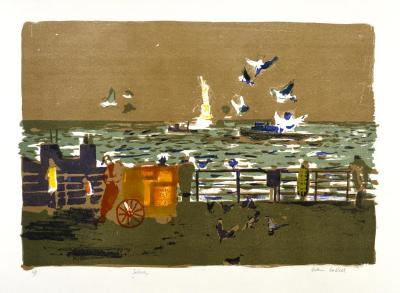Artist of the month: December 2015
Artist of the month: December 2015
Edwin La Dell, printmaker
By The RA Collections Team
Published 1 December 2015
Edwin La Dell is best known for his printmaking, in particular lithography, which he was a major exponent for in post-1945 British art.
-
La Dell was born in Rotherham in Yorkshire and began his training at Sheffield School of Art. In 1935 he won a scholarship to the Royal College of Art and studied etching, however he soon developed a passion for lithography which at the time, was not held in high esteem.
La Dell greatly admired the work of Henri Toulouse-Lautrec, Pierre Bonnard and Edouard Vuillard. These three were among the first artists to experiment with colour lithography as a means to produce original designs, rather than as a reproductive method.
During World War II, La Dell worked as an Official War Artist, commissioned for camouflage designs for the Civil Defence Camouflage Establishment in Leamington Spa and public murals. While on active service in Belgium, he maintained his artistic practice and after the war returned to the Royal College of Art and became Head of the School of Engraving in 1950. He developed the College’s lithography studio, which until that time had been severely lacking in London.
-

Edwin La Dell ARA, Goldfish, 1966.
Lithograph. © Royal Academy of Arts, London.
-
La Dell became involved with the Artists’ International Association who promoted the democratisation of fine art as something achievable and possible for all. The ease and relative cheapness with which lithographic prints could be made and sold meant that it soon gained a reputation as an affordable and accessible way for the wider public to purchase and own original art. La Dell was also interested in the medium’s potential for book illustration and in 1951 produced designs for Wilkie Collins’ The Moonstone.
La Dell’s lithographic method involved drawing on a zinc plate using a greasy medium such as chalk or ink. Then as with the usual lithographic process, water is added, which is naturally repelled from the oily areas where the medium has been applied. The surface is then rolled with ink, adhering to the greasy parts and the image is then transferred to paper via a press. To achieve a colour lithograph, each additional colour must be applied with a new stone or plate and tones are achieved through overprinting one colour on top of another, to blend them together.
-

Edwin La Dell ARA, George Washington Bridge, 1966.

Edwin La Dell ARA, Liberty, 1967–68.
-
During the 1960s, La Dell’s garden at his home in Kent inspired the subject matter of his prints. One of these is Goldfish (pictured). Both the mirror-like reflective surface of the garden’s lake and it’s transparency are beautifully executed. The goldfish appear as bright ochre-yellow spots against a palette of white, sage green and brown.
In 1967, La Dell and his wife the artist Joan Kohn travelled to New York. The atmosphere and appearance of the city spurred a creative outburst for La Dell and he produced a series of prints which captured iconic and distinctive aspects of the New York cityscape (George Washington Bridge; pictured). La Dell employed a variety of effects from strong patches of colour, soft washes and overprinting, to imbue the sense of vitality, unpredictability and fast-paced, brightly illuminated nature of New York City life.
December’s object of the month is Evelyn Sharp’s The Child’s Christmas, illustrated by Charles Robinson (1906). Find out more about the RA Collection.






